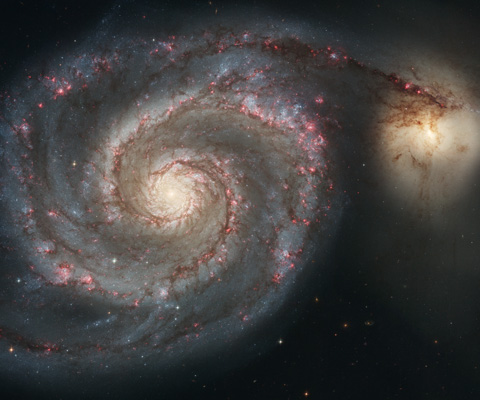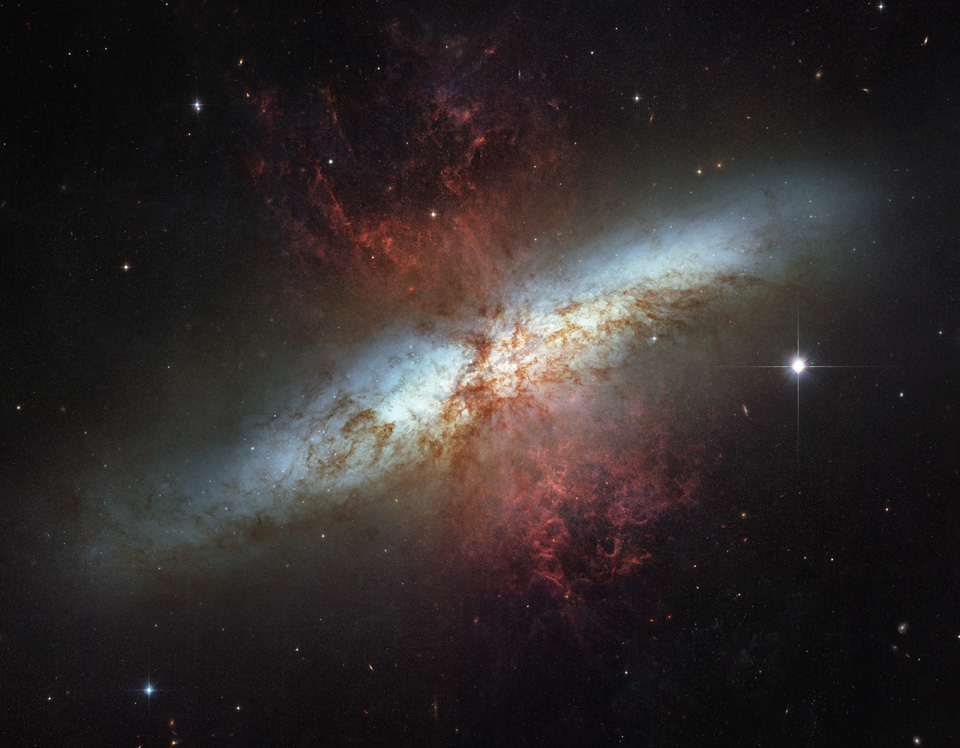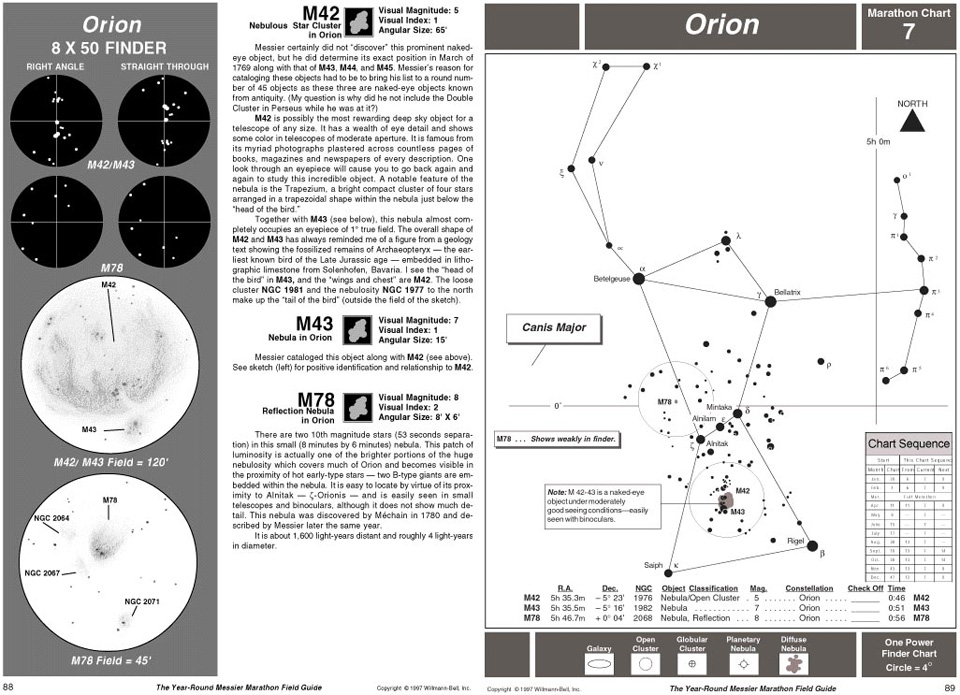Introduction
By no means complete, April’s mini guide that follows provides notes for exploring various interesting deep sky objects (DSOs) and lists other items of interest useful to the amateur astronomer.
Entries can be interpreted based on designation, description and magnitude as follows.
Designation – Description – Magnitude:
★ Telescopes 10-inch aperture minimum.
★★ Telescopes 6-inch to 9-inch aperture.
★★★ Binoculars (50mm+ aperture) and telescopes
3-inch to 5-inch aperture.
A collimated instrument, favourable atmospheric conditions, dark skies and dark-adapted eyes are assumed.

M51 spiral galaxy. Credit: NASA, ESA, S. Beckwith (STScI), and The Hubble Heritage Team (STScI/AURA).
About M51 spiral galaxy
The graceful, winding arms of the majestic spiral galaxy M51 (NGC 5194) appear like a grand spiral staircase sweeping through space. They are actually long lanes of stars and gas laced with dust.
This sharpest-ever image, taken in January 2005 with the Advanced Camera for Surveys aboard the NASA/ESA Hubble Space Telescope, illustrates a spiral galaxy's grand design, from its curving spiral arms, where young stars reside, to its yellowish central core, a home of older stars. The galaxy is nicknamed the Whirlpool because of its swirling structure.
The Whirlpool's most striking feature is its two curving arms, a hallmark of so-called grand-design spiral galaxies. Many spiral galaxies possess numerous, loosely shaped arms that make their spiral structure less pronounced. These arms serve an important purpose in spiral galaxies. They are star-formation factories, compressing hydrogen gas and creating clusters of new stars. In the Whirlpool, the assembly line begins with the dark clouds of gas on the inner edge, then moves to bright pink star-forming regions, and ends with the brilliant blue star clusters along the outer edge.
Some astronomers believe that the Whirlpool's arms are so prominent because of the effects of a close encounter with NGC 5195, the small, yellowish galaxy at the outermost tip of one of the Whirlpool's arms. At first glance, the compact galaxy appears to be tugging on the arm. Hubble's clear view, however, shows that NGC 5195 is passing behind the Whirlpool. The small galaxy has been gliding past the Whirlpool for hundreds of millions of years.
As NGC 5195 drifts by, its gravitational muscle pumps up waves within the Whirlpool's pancake-shaped disk. The waves are like ripples in a pond generated when a rock is thrown in the water. When the waves pass through orbiting gas clouds within the disk, they squeeze the gaseous material along each arm's inner edge. The dark dusty material looks like gathering storm clouds. These dense clouds collapse, creating a wake of star birth, as seen in the bright pink star-forming regions. The largest stars eventually sweep away the dusty cocoons with a torrent of radiation, hurricane-like stellar winds, and shock waves from supernova blasts. Bright blue star clusters emerge from the mayhem, illuminating the Whirlpool's arms like city streetlights.
The Whirlpool is one of astronomy's galactic darlings. Located approximately 25 million light-years away in the constellation Canes Venatici (the Hunting Dogs), the Whirlpool's beautiful face-on view and closeness to Earth allow astronomers to study a classic spiral galaxy's structure and star-forming processes.
Credit: NASA, ESA, S. Beckwith (STScI), and The Hubble Heritage Team (STScI/AURA).
| April deep sky objects |
| Ursa Major constellation |
|
M81
|
Bode’s Galaxy is one of the brightest galaxies in the Messier catalogue and shares the same field of view with the M82. The galaxy is visible in binoculars. CCD cameras, long exposures and large instruments will reveal two spiral arms of this face-on galaxy.
|
8.50
|
★★★
|
|
M82
|
The Cigar Galaxy is separated by 150,000 light years from the M81 and is approximately ten times smaller. Visible in binoculars the galaxy will reveal a degree of detail in instruments of 10-inch aperture and higher.
|
9.50
|
★★★
|
|
M97
|
The Owl Nebula is a popular target for more experienced observers. A moderate instrument and dark skies will be required to reveal the owl’s face.
|
12.0
|
★★
|
|
M101
|
A beautiful face-on galaxy occupying a relatively large part of the sky. Due to its low surface brightness it is a difficult object to observe. Medium sized instruments will show an oval patch of light, large instruments may show structure under dark skies. CCD cameras will reveal the galaxy’s intricate structure.
|
8.50
|
★★
|
| Coma Berenices constellation |
|
M64
|
The Black-Eye galaxy has taken its name from a dark dust lane near its centre. The lane may be visible in large instruments at high magnifications and under dark skies.
|
9.0
|
★★★
|
| Virgo constellation |
|
M49
|
A bright elliptical galaxy surrounded by a diffuse halo.
|
10.0
|
★★
|
|
M61
|
The Swelling Spiral is a face-on spiral galaxy that can be seen through smaller copes and large binoculars. Moderate size instruments and CCD cameras will show this galaxy’s arms.
|
10.5
|
★★
|
|
NGC4292
|
Faint galaxy close to the M61. Will require an 8-inch instrument or larger.
|
16.0
|
★
|
|
NGC4301
|
Faint galaxy close to the M61. Will require a 12-inch instrument or larger.
|
13.6
|
★
|
|
M58
|
A barred spiral galaxy in an area rich in deep sky objects. Large instruments will reveal subtle details at higher magnifications bringing out the galaxy’s structure.
|
11.0
|
★★★
|
|
M59
|
Elliptical galaxy paired with the M60. The galaxy consists of a bright core and diffuse halo.
|
11.5
|
★★
|
|
M60
|
Elliptical galaxy paired with the M60. Its companion galaxy NGC4647 has a black hole at its centre, 2 billion times the mass of our Sun making it one of the largest known black holes.
|
9.8
|
★★
|
|
NGC4638
|
Inclined spiral galaxy that requires at least a medium size instrument to resolve any detail.
|
12.1
|
★★
|
|
NGC4647
|
Face-on spiral galaxy and companion to the M60. CCD cameras will show detail.
|
12.1
|
★
|
|
M85
|
A lenticular bright galaxy visible in binoculars. A cross between a spiral and an elliptical galaxy the M85 appears as an oval glow with a bright centre.
|
10.5
|
★★★
|
|
M87
|
Giant elliptical galaxy with a halo made from over 15,000 globular clusters. It has a black hole at its centre, 3 billion times the mass of our Sun.
|
11.0
|
★★★
|
|
M88
|
Spiral galaxy. It will appear as an elongated glow in smaller instruments. Larger instruments and dark skies will reveal its spiral structure and bring forward its dark lanes.
|
11.0
|
★★★
|
|
M98
|
An almost edge-on spiral galaxy that appears as a thin elongated glow with a star like centre. Dark skies and larger instruments will show subtle detail. CCD cameras will capture its nucleus and spiral arms.
|
11.0
|
★★
|
|
M99
|
Face-on asymmetric spiral galaxy. CCD cameras will reveal the galaxy’s spiral arms. Large 14-Inch instruments may show one or both of the spiral arms under dark skies.
|
10.5
|
★★
|
| Canes Venatici constellation |
|
M51
|
The Whirlpool Galaxy is an impressive face-on galaxy. Under dark skies and good conditions, it is possible to visually observe the galaxy’s spiral arms. A bridge of nebulosity connects it to its companion galaxy NGC5195.
|
8.0
|
★★★
|
|
NGC5195
|
Companion galaxy to M51. It is possible that the gravitational pull exerted by the NGC5195 is causing star formation in the M51.
|
8.4
|
★★
|
|
NGC4449
|
Galaxy in Canes Venatici. It will not show detail in small instruments where it will appear as a patch of light but will show detail and possibly some structure in instruments of 10-inch aperture and above.
|
9.19
|
★★
|
|
NGC4244
|
Galaxy that appears as a long streak of light. The largest instruments may show some subtle detail.
|
10.7
|
★★
|
|
NGC5005
|
Spiral galaxy showing limited detail.
|
9.8
|
★★
|
|
NGC4631
|
Edge-on spiral galaxy with companion NGC4627. Moderate size instruments will discern some detail.
|
9.3
|
★★
|
|
NGC4656
|
Edge-on spiral galaxy with companion NGC4657. Moderate size instruments will discern some detail.
|
11.2
|
★★
|
|
M3
|
Globular cluster with around 500 stars. Best observed with a instrument at higher magnifications. Appears as a tiny patch of light in binoculars.
|
7.0
|
★★★
|
|
|
Designation, Description, Magnitude
|
★ Telescopes 10-inch aperture minimum.
★★ Telescopes 6-inch to 9-inch aperture.
★★★ Binoculars (50mm+ aperture) and telescopes 3-inch to 5-inch aperture.
|
The night sky
Under excellent conditions over 2,000 stars can be seen with the unaided eye but only a few hundred of these are prominent enough to be useful in navigating the night sky, these are normally included in amateur sky maps and digital planetarium programs like the SkySafari, Stellarium, The Sky, Starry Night, Winstars 2 etc. Some stars will show colour that is useful in identifying them. For example, Antares, Betelgeuse and Aldebaran are orange/red where Vega, Rigel and Spica appear as blue/white.
Stars that form easily recognisable patterns have been given names and are referred to as constellations. Of these, the brightest stars act as beacons and can be used to effectively navigate the night sky during the different months of the year. To that extent stars can be particularly useful in locating other interesting objects nearby normally viewable through binoculars or larger instruments.
Planets and their satellites, comets and meteors move independent of the night sky background and at comparatively high speeds. They are therefore very difficult or impossible to reference to any star. However, planets like Jupiter, Saturn, Venus and Mars as well as the Moon are easy to spot with the unaided eye and in the case of the larger planets and especially the Moon, even medium size binoculars will reveal a limited degree of detail.
M82 Cigar galaxy

M82 Cigar galaxy. Credit: NASA, ESA and the Hubble Heritage Team (STScI/AURA). Acknowledgment: J. Gallagher (University of Wisconsin), M. Mountain (STScI) and P. Puxley (NSF).
This mosaic image of the magnificent starburst galaxy, Messier 82 (M82) is the sharpest wide-angle view ever obtained of M82. It is a galaxy remarkable for its webs of shredded clouds and flame-like plumes of glowing hydrogen blasting out from its central regions where young stars are being born 10 times faster than they are inside in our Milky Way Galaxy.
Credit: NASA, ESA and the Hubble Heritage Team (STScI/AURA). Acknowledgment: J. Gallagher (University of Wisconsin), M. Mountain (STScI) and P. Puxley (NSF).
Sky conditions
The prevailing sky conditions will have a significant effect on what you can see through any instrument and binoculars. As such if you live near a city the light pollution can make it difficult to locate and observe most DSOs. The Moon and a hazy sky will also have a negative effect.
For best results observe from a dark site and under clear transparent skies without the moon being present. Once your eyes have been accustomed to the dark conditions (this takes around 20-30 minutes) you should be able to enjoy the night sky at its best.
Filters
Filters will help to an extent and lager instruments will benefit more from them. Light pollution filters would help and photo-visual UHC (nebula filters) would be worth considering.
Printed aids
A huge number of printed aids exist in terms of deep sky maps and books. An excellent printed guide for people new in astronomy is The Year-Round Messier Marathon Field Guide published by Willmann Bell Inc.
In this large format hard-back book, the author, Harvard Pennington shows how to:
- Learn 17 bright finder stars and 17 prominent finder constellations so you will know where to look for all 110 Messier objects.
- Align a sighting device such as an 8x50 finder scope or the Telrad® so that you can point your instrument rapidly and with assurance toward all of the Messier objects.
- Calibrate your instrument so that you know exactly how much sky you see through your finder and through the eyepiece of your instrument.
- Find all of the Messier objects using the maps, drawings and descriptions in this book. You will know exactly where to point your instrument, and what the object should look like when you find it.

Extract from The Year-Round Messier Marathon Field Guide
published by Willmann Bell Inc.
Related topics:
night sky, deep sky object guide, April



